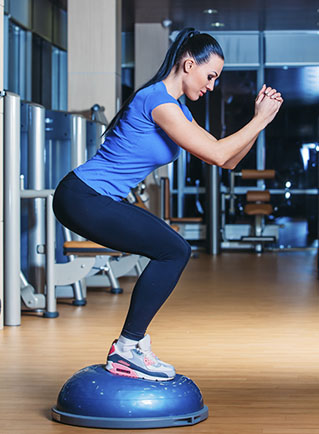Don’t Skip the Squats (but Do Them Right!)
November 9, 2015
Performing a squat is one of the most functional movements of human motion. The body mechanics are similar to those required in everyday life, such as sitting down, getting up and preparing to jump.
Squatting strengthens the gluteal (rear end) muscles and legs, especially quadriceps and hamstrings, and also conditions the low back, hips and knees. Squats are a useful exercise for nearly everyone!
Whether you’re trying to reshape your body, or lose weight with simple resistance exercises, squats are a building block of a powerfully effective workout routine.
Though it may seem like a simple move, the squat motion actually involves multiple joints (ankles, knees and hips), so it’s considered a rather complex exercise. It’s important to learn good squat form before attempting to perform them with added weight. And to avoid potential injury, practice your form until you can squat perfectly.
Here is a progression of three squat exercises, starting with body weight only from a seated position and graduating all the way up to adding free weights. Since it can be a tricky exercise to master, you might want to work through the nuances of your form with a trainer—remember, every XSport member has access to a free Personal Training session.
Body Weight Squats 101
A) From seated, for beginners:
- Take a seat on a bench that is high enough to put your bent knees at about a 90 degree angle. Place your feet shoulder-width apart with your toes straight ahead. Sit with a tall spine and engaged abs, looking forward.
- Putting your body weight back into your heels, reach your arms forward for balance and engage up your gluteal muscles while standing up. Take care not to arch or round your spine.
- Reverse the movement by squatting back toward the bench as if you are about to sit down again, with your arms reaching forward.
- Repeat to stand back up. Start with at least 5 repetitions, up to 15.
B) From standing, progressed squats:
- Stand with a tall spine, engaged abs, your feet shoulder-width apart with your toes straight ahead, looking forward.
- Putting your body weight back into your heels, reach your arms forward for balance and bend your knees, as if you were about to take a seat on a bench. Try to get as deep as a 90 degree angle with your bent knees. Take care not to arch or round your spine.
- Reverse the movement by standing back up, using your gluteal muscles to help you rise.
- Repeat to squat back down. Start with at least 5 repetitions, up to 15.
C) From standing, lightly-weighted squats:
- Stand with a tall spine, engaged abs, your feet shoulder-width apart with your toes straight ahead, looking forward, holding a bar (with no additional weight added) behind your head and shoulders.
- Holding the bar stable, put your body weight back into your heels and bend your knees, leaning slightly forward, as if you were about to take a seat on a bench. Take care not to arch your back or round your spine.
- Reverse the movement by standing back up, using your gluteal muscles to help you rise.
- Repeat to squat back down. Start with at least 5 repetitions, up to 15.
- You can begin to add weight, slowly, over time, as you master your squat sets.